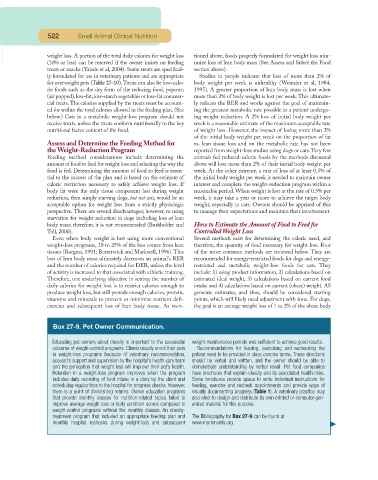Page 506 - Small Animal Clinical Nutrition 5th Edition
P. 506
522 Small Animal Clinical Nutrition
VetBooks.ir weight loss. A portion of the total daily calories for weight loss tioned above, foods properly formulated for weight loss min-
imize loss of lean body mass (See Assess and Select the Food
(10% or less) can be reserved if the owner insists on feeding
treats or snacks (Yaissle et al, 2004). Some treats are specifical- section above).
ly formulated for use in veterinary patients and are appropriate Studies in people indicate that loss of more than 2% of
for overweight pets (Table 27-10). Treats can also be low-calo- body weight per week is unhealthy (Weinsier et al, 1984,
rie foods such as the dry form of the reducing food, popcorn 1995). A greater proportion of lean body mass is lost when
(air popped), low-fat, low-starch vegetables or low-fat commer- more than 2% of body weight is lost per week. This ultimate-
cial treats. The calories supplied by the treats must be account- ly reduces the RER and works against the goal of maintain-
ed for within the total calories allowed in the feeding plan. (See ing the greatest metabolic rate possible in a patient undergo-
below.) Cats in a metabolic weight-loss program should not ing weight reduction. A 2% loss of initial body weight per
receive treats, unless the treats conform nutritionally to the key week is a reasonable estimate of the maximum acceptable rate
nutritional factor content of the food. of weight loss. However, the impact of losing more than 2%
of the initial body weight per week on the proportion of fat
Assess and Determine the Feeding Method for vs. lean tissue loss and on the metabolic rate has not been
the Weight-Reduction Program reported from weight-loss studies using dogs or cats. Very few
Feeding method considerations include determining the animals fed reduced-calorie foods by the methods discussed
amount of food to feed for weight loss and selecting the way the above will lose more than 2% of their initial body weight per
food is fed. Determining the amount of food to feed is essen- week. At the other extreme, a rate of loss of at least 0.5% of
tial to the success of the plan and is based on the estimate of the initial body weight per week is needed to maintain owner
caloric restriction necessary to safely achieve weight loss. If interest and complete the weight-reduction program within a
body fat were the only tissue component lost during weight reasonable period. When weight is lost at the rate of 0.5% per
reduction, then simply starving dogs, but not cats, would be an week, it may take a year or more to achieve the target body
acceptable option for weight loss from a strictly physiologic weight, especially in cats. Owners should be apprised of this
perspective. There are several disadvantages; however, to using to manage their expectations and maintain their involvement.
starvation for weight reduction in dogs including loss of lean
body mass; therefore, it is not recommended (Burkholder and How to Estimate the Amount of Food to Feed for
Toll, 2000). Controlled Weight Loss
Even when body weight is lost using more conventional Several methods exist for determining the caloric need, and
weight-loss programs, 10 to 25% of the loss comes from lean therefore, the quantity of food necessary for weight loss. Four
tissues (Burgess, 1991; Butterwick and Markwell, 1996). This of the more common methods are reviewed below. They are
loss of lean body mass ultimately decreases an animal’s RER recommended for energy-restricted foods for dogs and energy-
and the number of calories required for DER, unless the level restricted and metabolic weight-loss foods for cats. They
of activity is increased to that associated with athletic training. include: 1) using product information, 2) calculations based on
Therefore, one underlying objective in setting the number of estimated ideal weight, 3) calculations based on current food
daily calories for weight loss is to restrict calories enough to intake and 4) calculations based on current (obese) weight. All
produce weight loss, but still provide enough calories, protein, generate estimates, and thus, should be considered starting
vitamins and minerals to prevent or minimize nutrient defi- points, which will likely need adjustment with time. For dogs,
ciencies and subsequent loss of lean body tissue. As men- the goal is an average weight loss of 1 to 2% of the obese body
Box 27-9. Pet Owner Communication.
Educating pet owners about obesity is important to the successful weight-maintenance periods was sufficient to achieve good results.
outcome of weight-control programs. Clients usually enroll their pets Recommendations for feeding, exercising and rechecking the
in weight-loss programs because of veterinary recommendation, patient need to be provided in clear, concise terms. These directions
access to support and supervision by the hospital’s health care team should be verbal and written, and the owner should be able to
and the perception that weight loss will improve their pet’s health. demonstrate understanding by verbal recall. Pet food companies
Retention in a weight-loss program improves when the program have brochures that explain obesity and its associated health risks.
includes daily recording of food intake in a diary by the client and Some brochures provide space to write individual instructions for
scheduling regular trips to the hospital for progress checks. However, feeding, exercise and recheck appointments and provide ways of
there is a point of diminishing returns. Owner education programs visually documenting progress (Table 1). A veterinary practice may
that provide monthly classes for nutrition-related topics failed to also elect to design and distribute its own printed or computer-gen-
improve average weight loss or body condition scores compared to erated material for this purpose.
weight-control programs without the monthly classes. An obesity-
treatment program that included an appropriate feeding plan and The Bibliography for Box 27-9 can be found at
monthly hospital rechecks during weight-loss and subsequent www.markmorris.org.

